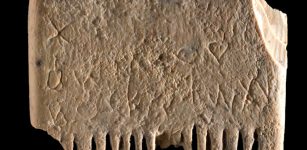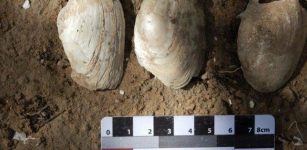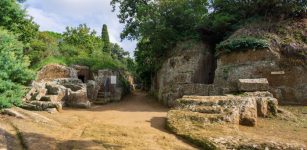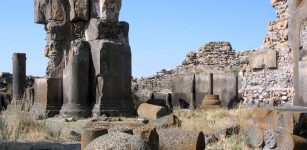Brooklyn Papyrus Reveals Ancient Egypt Had Far More Venomous Snakes Than The Country Today
AncientPages.com - How much can the written records of ancient civilizations tell us about the animals they lived alongside?
Published in Environmental Archaeology, Our latest research, based on the venomous snakes described in an ancient Egyptian papyrus, suggests more than you might think. A much more diverse range of snakes than we'd imagined lived in the land of the pharaohs—which also explains why these Egyptian authors were so preoccupied with treating snakebites!
Many snakes were probably much more widespread in ancient Egypt. Composite image. Mamba: W. Wüster. Pyramids: Ricardo Liberato, CC BY-SA 2.0. Montage: W. Wüster.
Like cave paintings, texts from early in recorded history often describe wild animals the writers knew. They can provide some remarkable details, but identifying the species involved can still be hard. For instance, the ancient Egyptian document called the Brooklyn Papyrus, dating back to around 660–330BC but likely a copy of a much older document, lists different kinds of snakes known at the time, the effects of their bites, and their treatment.
As well as the symptoms of the bite, the papyrus also describes the deity associated with the snake, or whose intervention might save the patient. The bite of the "great snake of Apophis" (a god who took the form of a snake), for example, was described as causing rapid death. Readers were also warned that this snake had not the usual two fangs but four, still a rare feature for a snake today.
The venomous snakes described in the Brooklyn Papyrus are diverse: 37 species are listed, of which the descriptions for 13 have been lost. Today, the area of ancient Egypt is home to far fewer species. This has led to much speculation among researchers as to which species are being described.
The four-fanged snake
For the great snake of Apophis, no reasonable contender currently lives within ancient Egypt's borders. Like most of the venomous snakes that cause the majority of the world's snakebite deaths, the vipers and cobras now found in Egypt have just two fangs, one in each upper jaw bone. In snakes, the jaw bones on the two sides are separated and move independently, unlike in mammals.
The boomslang (Dispholidus typus) is now restricted to sub-Saharan savannas. Credit: W. Wüster
The nearest modern snake that often has four fangs is the boomslang (Disopholidus typus) from the sub-Saharan African savannas, now only found more than 400 miles (650km) south of present-day Egypt. Its venom can make the victim bleed from every orifice and cause a lethal brain hemorrhage. Could the snake of Apophis be an early, detailed description of a boomslang? And if so, how did the ancient Egyptians encounter a snake that now lives so far south of their borders?
To find out, our masters student Elysha McBride used a statistical model called climate niche modeling to explore how the ranges of various African and Levantine (eastern Mediterranean) snakes have changed through time.
Niche modeling reconstructs the conditions in which a species lives, and identifies parts of the planet that offer similar conditions. Once the model has been taught to recognize places that are suitable today, we can add in maps of past climate conditions. It then produces a map showing all the places where that species might have been able to live in the past.
On the trail of ancient snakes
Our study shows the much more humid climates of early ancient Egypt would have supported many snakes that don't live there today. We focused on ten species from the African tropics, the Maghreb region of north Africa and the Middle East that might match the papyrus's descriptions. These include some of Africa's most notorious venomous snakes such as the black mamba, puff adder and boomslang.
We found that 9 of our 10 species could probably once have lived in ancient Egypt. Many could have occupied the southern and southeastern parts of the country as it then was—modern northern Sudan and the Red Sea coast. Others might have lived in the fertile, vegetated Nile valley or along the northern coast. For instance, boomslangs might have lived along the Red Sea coast in places that 4,000 years ago would have been part of Egypt.
Similarly, one entry of the Brooklyn Papyrus describes a snake "patterned like a quail" that "hisses like a goldsmith's bellows." The puff adder (Bitis arietans) would fit this description, but currently lives only south of Khartoum in Sudan and in northern Eritrea. Again, our models suggest that this species' range would once have extended much further north.
Representation of Apep (Apophis) in Ancient Egyptian wall painting. Note resemblance to boomslang (above).
Since the period we modeled, a lot has changed. Drying of the climate and desertification had set in about 4,200 years ago, but perhaps not uniformly. In the Nile valley and along the coast, for instance, farming and irrigation might have slowed the drying and allowed many species to persist into historical times. This implies that many more venomous snakes we only know from elsewhere might have been in Egypt at the time of the pharaohs.
Our study shows how enlightening it can be when we combine ancient texts with modern technology. Even a fanciful or imprecise ancient description can be highly informative. Modeling modern species' ancient ranges can teach us a lot about how our ancestors' ecosystems changed as a result of environmental change. We can use this information to understand the impact of their interactions with the wildlife around them.
The study was published in the journal Environmental Archaeology
Written by Isabelle Catherine Winder, Senior Lecturer in Zoology, Bangor University and Wolfgang Wüster, Professor of Zoology, Bangor University
Provided by The Conversation
This article is republished from The Conversation under a Creative Commons license. Read the original article.
More From Ancient Pages
-
 Why Napoleon’s Invasion Of Russia Was A Fiasco
Ancient History Facts | Mar 31, 2017
Why Napoleon’s Invasion Of Russia Was A Fiasco
Ancient History Facts | Mar 31, 2017 -
 Yet Another Beautiful Roman Mosaic In Hatay, Turkey
Archaeology | Jul 14, 2022
Yet Another Beautiful Roman Mosaic In Hatay, Turkey
Archaeology | Jul 14, 2022 -
 On This Day In History: National Hero Paul Revere Warns Of The British Coming – On Apr 18, 1775
News | Apr 18, 2017
On This Day In History: National Hero Paul Revere Warns Of The British Coming – On Apr 18, 1775
News | Apr 18, 2017 -
 Ancient Roman Coffin Found In Leeds Revealed To The Public For The First Time
Archaeology | Apr 22, 2024
Ancient Roman Coffin Found In Leeds Revealed To The Public For The First Time
Archaeology | Apr 22, 2024 -
 Early Bantu Speakers Crossed Through The Dense Central African Rainforest 4,000 Years Ago
Archaeology | Aug 2, 2022
Early Bantu Speakers Crossed Through The Dense Central African Rainforest 4,000 Years Ago
Archaeology | Aug 2, 2022 -
 Mystery Of The Unique Tiarp Dolmen – One Of Oldest The Stone Burial Chambers In Scandinavia
Archaeology | Jan 30, 2024
Mystery Of The Unique Tiarp Dolmen – One Of Oldest The Stone Burial Chambers In Scandinavia
Archaeology | Jan 30, 2024 -
 Immense Ancient Copper Mine Used By Romans Unearthed In Spain
Archaeology | Mar 20, 2017
Immense Ancient Copper Mine Used By Romans Unearthed In Spain
Archaeology | Mar 20, 2017 -
 Breakthrough – First Sentence Ever Written In Canaanite Language Discovered – What Does It Say?
Archaeology | Nov 9, 2022
Breakthrough – First Sentence Ever Written In Canaanite Language Discovered – What Does It Say?
Archaeology | Nov 9, 2022 -
 Aboriginals Inhabited South Australia 29,000 Years Ago – New Study
Archaeology | Jul 15, 2020
Aboriginals Inhabited South Australia 29,000 Years Ago – New Study
Archaeology | Jul 15, 2020 -
 Secrets Of A Lake That Could Re-Write Ancient History Of America – Ancient Visitors From Distant Countries – Part 3
Ancient Mysteries | Jun 6, 2018
Secrets Of A Lake That Could Re-Write Ancient History Of America – Ancient Visitors From Distant Countries – Part 3
Ancient Mysteries | Jun 6, 2018 -
 ‘Armenian Stonehenge’: 30 Unknown Stones In Carahunge Complex – Surveyed
Archaeology | Aug 12, 2020
‘Armenian Stonehenge’: 30 Unknown Stones In Carahunge Complex – Surveyed
Archaeology | Aug 12, 2020 -
 Unique Tomb Of Roman Noblewoman Caecilia Metella Reveals Secrets Of Ancient Concrete Resilience
Archaeology | Oct 14, 2021
Unique Tomb Of Roman Noblewoman Caecilia Metella Reveals Secrets Of Ancient Concrete Resilience
Archaeology | Oct 14, 2021 -
 ‘Sesselfelsgrotte Cave’ – Innovative Neanderthals Adjusted To Climate Change By Creating More Complex Tools
Artifacts | Aug 31, 2020
‘Sesselfelsgrotte Cave’ – Innovative Neanderthals Adjusted To Climate Change By Creating More Complex Tools
Artifacts | Aug 31, 2020 -
 DNA Analysis Of Human Remains In Early Medieval Alemannic Graveyard
Archaeology | Sep 6, 2018
DNA Analysis Of Human Remains In Early Medieval Alemannic Graveyard
Archaeology | Sep 6, 2018 -
 Antediluvian Discoveries In Britain, Germany And France That Could Re-Write History
Ancient Mysteries | Jan 4, 2019
Antediluvian Discoveries In Britain, Germany And France That Could Re-Write History
Ancient Mysteries | Jan 4, 2019 -
 Unique, Well-Preserved 4,000-Year-Old Boat Discovered Near The Ancient City Of Uruk
Archaeology | Apr 4, 2022
Unique, Well-Preserved 4,000-Year-Old Boat Discovered Near The Ancient City Of Uruk
Archaeology | Apr 4, 2022 -
 Armenia: Old Land Where Myths, Legends And Long History Meet
Civilizations | Apr 20, 2016
Armenia: Old Land Where Myths, Legends And Long History Meet
Civilizations | Apr 20, 2016 -
 On This Day In History: Thomas Cromwell Arrested In Westminster – On June 10, 1540
News | Jun 10, 2016
On This Day In History: Thomas Cromwell Arrested In Westminster – On June 10, 1540
News | Jun 10, 2016 -
 Etruscan City Of Cerveteri With Magnificent House-Like Tombs Decorated With Scenes From Life And Death
Featured Stories | May 17, 2022
Etruscan City Of Cerveteri With Magnificent House-Like Tombs Decorated With Scenes From Life And Death
Featured Stories | May 17, 2022 -
 Ancient Great City Of Ani: Lost Capital Of The Kingdom Of Armenia And Its Mysterious Underground Tunnels
Featured Stories | Feb 18, 2016
Ancient Great City Of Ani: Lost Capital Of The Kingdom Of Armenia And Its Mysterious Underground Tunnels
Featured Stories | Feb 18, 2016



